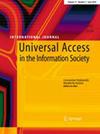The role of interface configuration on performance accuracy in eyes-free touchscreen interaction
IF 2.7
4区 计算机科学
Q3 COMPUTER SCIENCE, CYBERNETICS
引用次数: 0
Abstract
Abstract This paper describes the exploration of a new category of a touchscreen interface. An eyes-free interface harnesses innate human abilities and product affordances to allow reduced levels of visual attention. Interface design for eyes-free interaction with a featureless screen is highly challenging; however, it can be achieved by simplifying and optimizing menu layout patterns to take advantage of innate human abilities including proprioception and spatial memory. This opens up a range of possibilities for peripheral device control under one-handed thumb mobile interaction. To this end, two experiments with different modes of presentation were conducted to understand the effect of interface configurations on performance accuracy caused by spatial memory and proprioception. Spatial performance results from the interaction effect of both cognitive abilities on an eyes-free interface. Vertical, horizontal, diagonal, and curved layouts with different spacing patterns have been tested in both tap and draw input modes. The results revealed that evenly spaced button alignment close to the reference frame with symmetrical patterns within a square interface area and a comfortable thumb range positively affect accuracy. The conclusions describe how alignment patterns and the mode of presentation affect visual perception and spatial integration, and a framework for the development of an eyes-free interface is set out.无眼触摸屏交互中界面配置对性能精度的影响
摘要:本文介绍了一种新型触摸屏界面的探索。无眼界面利用了人类与生俱来的能力和产品的特性来降低视觉注意力水平。无眼交互和无特色屏幕的界面设计是极具挑战性的;然而,这可以通过简化和优化菜单布局模式来实现,以利用人类固有的能力,包括本体感觉和空间记忆。这为单手拇指移动交互下的外围设备控制开辟了一系列可能性。为此,我们进行了两个不同呈现模式的实验,以了解界面配置对空间记忆和本体感觉引起的表现准确性的影响。空间表现是两种认知能力在无眼界面上相互作用的结果。垂直,水平,对角线和曲线布局具有不同的间距模式已经在点击和绘制输入模式下进行了测试。结果表明,在一个正方形的界面区域内,接近参考框架的均匀间隔的按钮对齐和对称的图案以及舒适的拇指范围对精度有积极的影响。结论描述了对齐模式和呈现模式如何影响视觉感知和空间整合,并提出了开发无眼界面的框架。
本文章由计算机程序翻译,如有差异,请以英文原文为准。
求助全文
约1分钟内获得全文
求助全文
来源期刊

Universal Access in the Information Society
COMPUTER SCIENCE, CYBERNETICS-
CiteScore
6.10
自引率
16.70%
发文量
81
审稿时长
>12 weeks
期刊介绍:
Universal Access in the Information Society (UAIS) is an international, interdisciplinary refereed journal that solicits original research contributions addressing the accessibility, usability, and, ultimately, acceptability of Information Society Technologies by anyone, anywhere, at anytime, and through any media and device. Universal access refers to the conscious and systematic effort to proactively apply principles, methods and tools of universal design order to develop Information Society Technologies that are accessible and usable by all citizens, including the very young and the elderly and people with different types of disabilities, thus avoiding the need for a posteriori adaptations or specialized design. The journal''s unique focus is on theoretical, methodological, and empirical research, of both technological and non-technological nature, that addresses equitable access and active participation of potentially all citizens in the information society.
 求助内容:
求助内容: 应助结果提醒方式:
应助结果提醒方式:


